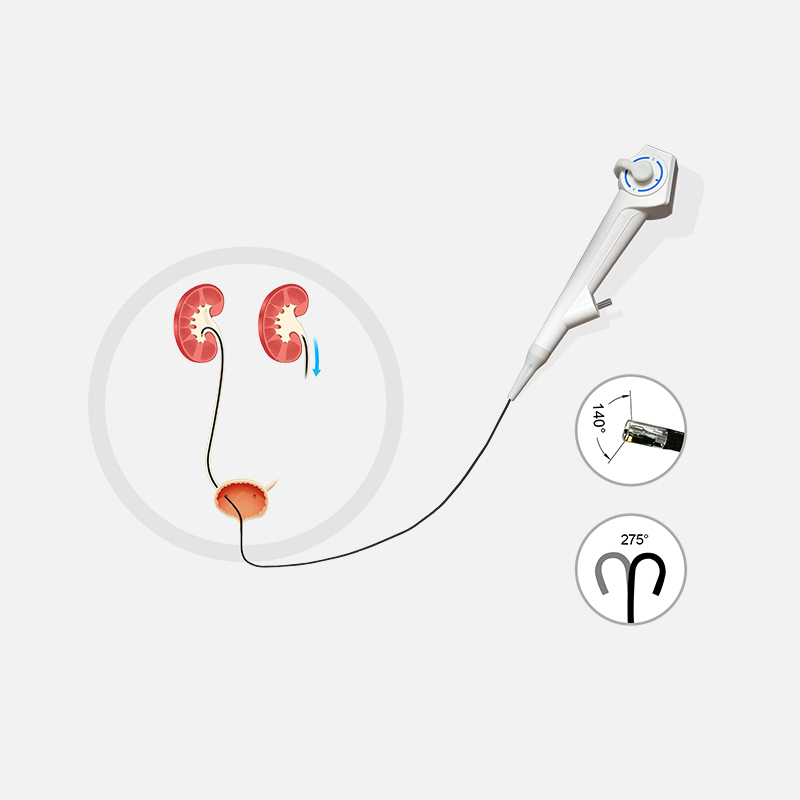| Availability: | |
|---|---|
| Quantity: | |
GEV-341
GEIWRE








Advance your minimally invasive urological interventions with the HD Electric Video Ureteroscope Flexible. This sophisticated instrument combines high-definition (1920x1080) digital imaging with the flexibility and precision needed for navigating the intricate upper urinary tract. Featuring an integrated digital sensor at the distal tip (chip-on-tip technology), it eliminates the need for a separate camera head, delivering superior image quality directly to the monitor with minimal light loss and zero chromatic aberration. The flexible shaft provides excellent maneuverability through tortuous ureters and into the renal pelvis, enabling clear visualization for diagnostic and therapeutic procedures like stone management and tumor assessment. Compatible with standard ureteroscopic accessories.
Product Specifications
| Diameter (MM) | Length (customizable) | Inside diameter of working passage | Angle of bend | Pixel | Depth of field | Field angle |
| 2.3 | 680 | 1.2±0.04 | ≥275° | 16W/30W | 5-150MM | 140° |
| 2.8 | 680 | 1.2±0.04 | ≥275° | 16W/30W | 5-150MM | 140° |
| 4.3 | 680 | 2.2±0.04 | Turn up 210° Turn down 210° | 16W/30W/50W | 5-150MM | 140° |
Single Use Digital Flexible Ureteroscope Advantage
High-Definition Digital Imaging (1920x1080)
The Bullet Head is Inserted Into the Head, Allowing for Easy Entry Into the Device And The Body.
No cross-infection
Compatible with ALL-In-One GEIWRE IMAGE Processom And Foreign brand equipment
Disposable,No maintenance
Ergonomic design and lightweight structure reduce the workload of operators
Single Use Digital Flexible Ureteroscope Key Features
CMOS chip on tip of the endoscope,no need light source
Two-handed wheel rotation with water vapour buttons, frozen, video/photo, etc.
All-in-one endoscope body, with forcep hole, compound bending 270 °
The endoscope body rotates 90 °, field of view 140 °
Working length 400-1800mm.
Usb interface with portable Tablet can be avilable
Single Use Digital Flexible Ureteroscope Applications
Diagnostic Uses
Lesion Visualization
Biopsy Sampling
Therapeutic Uses
Stent Placement Assistance
Stone Fragmentation & Removal
Distal Chip-on-Tip HD Sensor: Direct digital imaging for exceptional clarity, brightness, and color accuracy (1080p).
Active 4-Way Deflection: High-degree, bi-directional tip deflection (often >270° up/down) for accessing lower pole calyces.
Integrated Design: Eliminates separate camera head, reducing setup time and potential points of failure.
Large Instrument Channel: Accommodates standard laser fibers (200µm/365µm), baskets, graspers, and biopsy tools.
Ergonomic Control Body: Intuitive lever for deflection and ports for irrigation/accessories.
High-Resolution Imaging: Reveals fine details of urothelium, stones, and tumors.
Durable Construction: Engineered for repeated sterilization cycles and clinical longevity.
Compatibility: Works with standard HD endoscopic light sources and video processors/monitors via digital (e.g., DVI/HDMI) connection.
Reduced Fogging: Often features integrated irrigation channels near the lens.
Essential for complex diagnostic and therapeutic upper urinary tract procedures: Diagnostic Flexible Ureteroscopy (URS), Ureteroscopic Lithotripsy (URS-L) for kidney/ureter stones (laser fragmentation), Treatment of Upper Tract Urothelial Carcinoma (Biopsy, Ablation), Ureteropelvic Junction (UPJ) Obstruction Assessment, Foreign Body Retrieval, Management of Strictures, and Calyceal Diverticulum Treatment. Its flexibility and image quality are critical for lower pole access and detailed mucosal inspection.
Q: What is "chip-on-tip" technology?
A: The image sensor is located at the very tip of the ureteroscope, capturing light directly for superior image quality compared to fiberoptic or lens-based systems.
Q: What deflection angle does it offer?
A: Typically >270 degrees in both directions, crucial for accessing the lower pole calyces in the kidney.
Q: What size laser fiber fits?
A: Standard 200µm and 365µm holmium laser fibers fit through the large instrument channel.
Q: How is it sterilized?
A: Designed for standard low-temperature sterilization methods like EtO gas or hydrogen peroxide plasma (check manufacturer specs).
Q: Does it require a special light source?
A: It requires a standard xenon or LED endoscopic light source connected via a light guide cable.



